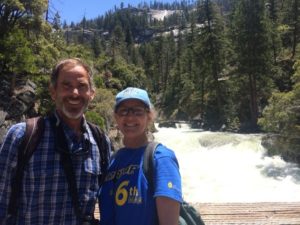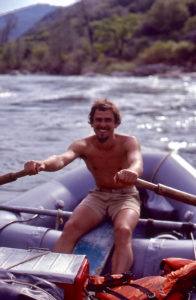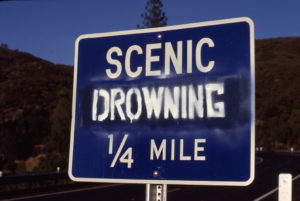Finding the Stanislaus – 1,000 Heroes & a Hard Loss.
by Alexander Gaguine #read-more

During college, in my hometown of Washington DC, I took geology and was jolted by photos of Shiprock, the Grand Canyon, and Devil’s Tower. Having never given much thought to “the West,” I now needed to see those places! Being 1971, I hitch-hiked through Iowa and the Rockies, past Shiprock, hiked down and up the Bright Angel Trail in the Grand Canyon, then back on the road to San Diego and San Francisco and home, all in three weeks.
By 1973, I was living in Salt Lake. Again while hitchhiking, I was told that there were trips through the Grand Canyon in rubber rafts! I was astonished by that idea, and knew I should do that! I hitched to Lee’s Ferry and begged for trips. Liz Hymans showed up on the same day to do the same thing. I scored a trip as an assistant to Bart Henderson.
A year later, I was an assistant boatman on a Grand rowing trip with ARTA. A wild boatman, Bob McGavern, said I had to, had to, had to go see the Stanislaus River in California. That seemed quite an imperative when you’re already in the bottom of the Grand Canyon. After I could get no more Canyon trips, I went to visit Debbie Dohm in Marin County – I had met her at Phantom Ranch (in the Grand Canyon) when she boarded one of the trips I had worked on. We had agreed we’d both really like to see more of the beautiful West. So I flew to eye-opening California. She picked me up and took me to the ranch caretaker cabin in a crease in the hills where her family lived. I had never before experienced such warmth and welcoming.

We quickly made our way to the Stanislaus put-in, Camp Nine, on August 14, 1974, in her VW and with a tiny blue and yellow Taiwan rubber duckie. We floated the river a few times, mostly successfully. It was just about the coolest thing I’d ever done! We took the same boat down the Rogue River, and also hiked up Mt. Shasta, walked down to the Colorado River through Havasu Canyon, explored Point Reyes, and more.
I started working summers for OARS. In 1976, I volunteered in Sacramento for the campaign for the Stanislaus, aka Friends of the River. Mark Dubois pulled me in with big hugs. Deb soon joined the group. I was eager to work and had not been involved in, or burned by, the earlier loss of Prop 17. I was at FOR for the next 5 years, up to, and sometimes over, my head. Nothing has ever been more clear to me than the senselessness and even criminality of destroying that river canyon, spectacular and alive, and home to a wonderful community of people. FOR had the closest and most intense camaraderie I ever knew, in our offices, at the river, and all around the state. I made most of the best friends of my life there.

I got to be part of the decision in 1976 that decided FOR would work for lots of rivers, not just the Stanislaus (although that continued to be by far the main effort). I was part of the more difficult decision, in 1978, admitting that the dam was almost built and was going to be completed, and that we had to give up on trying to save the stretch down to Highway 49, yet we were resolved to hold the reservoir below 808 feet. I think it was Melinda Wright who said, “Parrotts Ferry is the Limit!” I organized demonstrations including one at the Capitol for where people pulled a Toyon bush from the Stanislaus Canyon by wagon for seven days to plant under the governor’s window. I coordinated group lobbying days. I wrote, pasted up and tried to distribute increasingly frantic “action alerts.” I organized the “witness and encampment” in which groups from all over the state recorded the drowning as it moved upstream. The great David Brower came to that. I was involved in Mark’s and others’ “chained to the canyon” nonviolent actions. I hung on through our loss in Congress in 1980 and the final environmental blow of the Reagan ascendancy. All of it was hard.
The destruction of the Stanislaus River and canyon was far and away the most painful event in my life. An untold number of people shared that grief. People die, but rivers and whole canyons are not supposed to perish and disappear. Forty years later it’s still hard.
[I wrote a brief narrative of that campaign, published a few years ago in Headwaters.]
I got to play a smaller role in the extraordinary campaign that protected the Tuolumne River as Wild and Scenic. FOR was one of the players in this. It was a huge victory, connected to the Stanislaus, and it took away a little of the sting. The campaign was brilliant and historic and ultimately joyous, but we didn’t “gain” a river – we just kept it from also being destroyed.
One among a great many memories of the Stanislaus is this – floating toward Parrotts Ferry in the late afternoon light, with lots of violet-green swallows skimming and swerving over the river, flashing and gleaming their bright colors.
